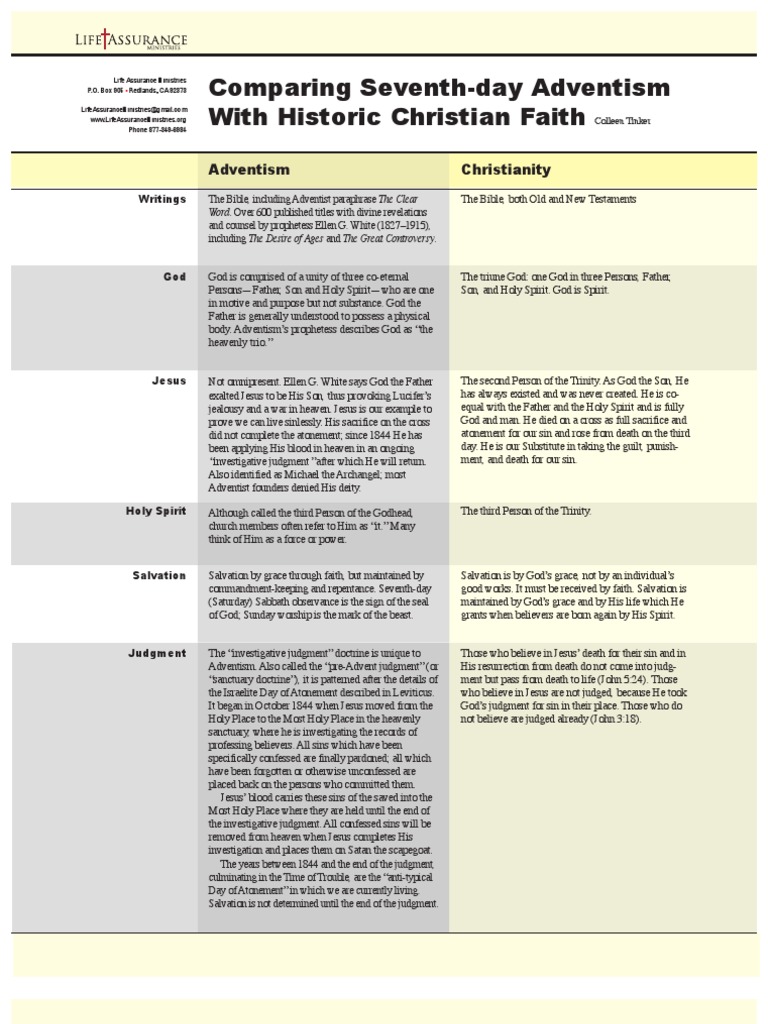In the realm of contemporary Christianity, the distinctions among various denominations can often engender confusion, particularly when it comes to groups like the Seventh-day Adventists and Mormons, formally known as members of The Church of Jesus Christ of Latter-day Saints (LDS). While both groups emerged during the American religious revival of the 19th century and share some foundational Christian beliefs, their theology, practices, and worldviews differ significantly. Understanding these differences is essential for a comprehensive grasp of their distinct identities within the broader Christian spectrum.
To begin, the theological underpinnings of the Seventh-day Adventist Church starkly contrast with those of Mormonism. The Seventh-day Adventist Church, established in the 1860s, is firmly rooted in Protestant Christianity. It emphasizes a literal interpretation of the Bible, adherence to the Ten Commandments, and the observance of the Sabbath on Saturday, which they consider the true Sabbath day, as a reflection of their commitment to God’s laws. By contrast, Mormonism’s doctrine is predicated on a canon that extends beyond the Bible, incorporating the Book of Mormon and other texts as scripture. This foundational divergence leads to varying beliefs concerning the nature of God, Jesus Christ, and salvation.
Seventh-day Adventists believe in the Trinity, viewing God as one being existing in three persons: the Father, the Son, and the Holy Spirit. In stark contrast, Mormons reject the traditional doctrine of the Trinity. They advocate for a view of God that posits a separate God the Father, Jesus Christ, and the Holy Ghost, each as distinct beings united in purpose rather than essence. This theological distinction leads to divergent views on key topics such as the divinity of Christ and the concept of salvation.
In discussing salvation, the Seventh-day Adventist perspective emphasizes grace through faith and the importance of adhering to God’s commandments as part of the sanctification process. They believe that obedience to God’s law is a response to His grace, not a means of earning salvation. Conversely, Mormons believe that salvation is a two-part process that involves both grace and works. The LDS Church teaches that individuals must follow a series of prescribed ordinances and covenants, such as baptism and temple ceremonies, to attain the highest degree of glory in the afterlife. This fundamental contrast in soteriology illustrates how each group views the relationship between divine grace and human agency.
Another noteworthy distinction lies in the eschatological beliefs of each group. Seventh-day Adventists are well known for their apocalyptic theology and their emphasis on the imminent return of Jesus Christ, known as the “Second Advent.” This belief informs their lifestyle choices, such as abstinence from certain foods and practices deemed harmful, as a form of preparation for Christ’s return. Mormons, while also anticipating the Second Coming, do not place the same degree of urgency on imminent eschatology. Their teachings have a more pronounced focus on establishing God’s kingdom on Earth through missionary work and community service.
Practices within each faith also reflect their distinct identities. The Seventh-day Adventist Church promotes a holistic lifestyle, advocating for healthful living, vegetarianism, and abstinence from substances like alcohol and tobacco. Their understanding of the body as a temple of the Holy Spirit influences this lifestyle advocacy. In contrast, Mormons have unique practices surrounding family life and community, placing a high value on familial relationships and temple worship. Family is central to the LDS faith, and Mormons believe in the eternal nature of familial bonds, which influences their emphasis on genealogical research and temple work in behalf of deceased ancestors.
Cultural expressions within each denomination further illustrate their differences. Seventh-day Adventists tend to focus on educational institutions and health initiatives, creating a global network of Adventist schools and hospitals that reflect their commitment to service and education. Conversely, the LDS Church maintains a strong emphasis on missionary work, with vast resources dedicated to spreading its teachings worldwide, supported by an extensive church structure that facilitates lay ministry.
Moreover, the communal aspect of each faith also varies. Seventh-day Adventist congregations are known for their emphasis on fellowship, often gathering for worship on Saturdays, aligned with their Sabbath observance. Worship services typically consist of singing hymns, prayer, and sermons focused on biblical teachings. Meanwhile, Mormons gather on Sundays for services that include meetings at local chapels, sacrament services, and various classes. Their worship practices emphasize community involvement, with members often participating in church leadership roles as part of their call to serve.
In conclusion, while both Seventh-day Adventists and Mormons arose during a time of religious fervor in America and have a common affinity for certain Christian principles, their beliefs and practices diverge in compelling ways. From differing views on scripture to distinctive teachings on salvation, eschatology, and lifestyle choices, each has crafted a rich theological and cultural identity. Understanding these differences not only clarifies their individual contributions to the tapestry of Christianity but also enriches the broader discourse surrounding faith and practice in an increasingly diverse religious landscape. The fascination with these two groups lies not just in their differences but also in their unique responses to the perennial questions of faith, community, and the divine.



